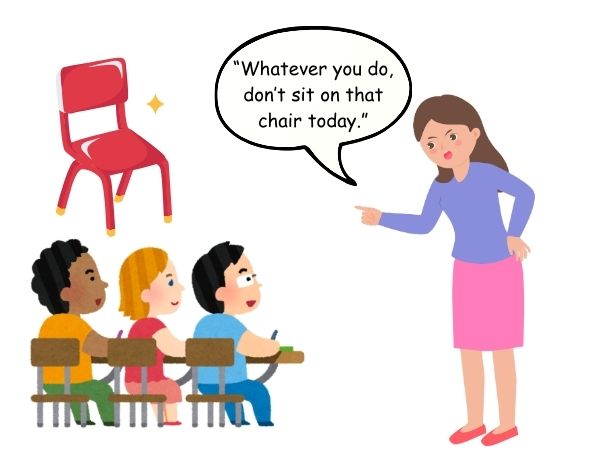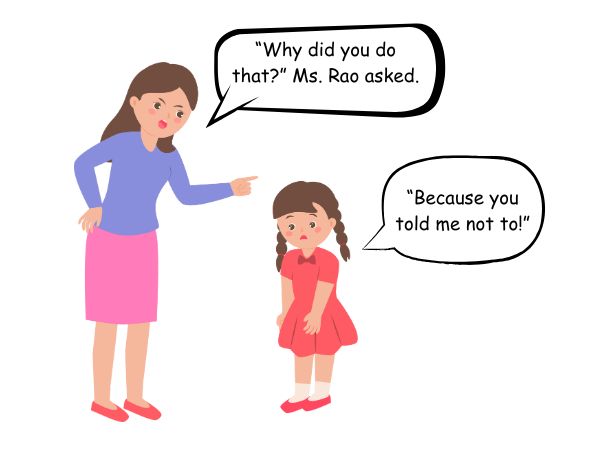🎭 The Story of the Forbidden Chair
Ms. Rao, a high school teacher, wanted to try something new to spark curiosity in her students. At the start of class, she pointed to a bright red chair in the corner and firmly said:
“Whatever you do, don’t sit on that chair today.”

The students glanced at each other. No one had ever noticed that chair before. As the lesson went on, their eyes kept drifting back to it. By the middle of class, one brave student, Ananya, slowly walked toward it. The rest of the class leaned forward in suspense.
With a grin, she sat down.

“Why did you do that?” Ms. Rao asked.
“Because you told me not to!” Ananya laughed, and the entire class erupted in giggles.
At that moment, Ms. Rao explained:
“This, my dear students, is what psychologists call psychological reactance—the natural resistance we feel when our freedom to choose is restricted. The more someone tells us not to do something, the stronger the urge to do it becomes.”
From then on, whenever she set classroom rules, Ms. Rao framed them as choices rather than commands. Instead of saying “You must submit homework today,” she said, “You can choose to submit your homework today and get feedback early, or wait until tomorrow, but then you’ll miss the chance for corrections.”
The students began following rules more willingly, not because they were forced, but because they felt their freedom was respected.
✨ Key Takeaway for Teachers
Psychological Reactance is the resistance people feel when they perceive their choices are being restricted.
In the classroom, students may rebel when they feel controlled.
Framing instructions as choices, offering autonomy, and explaining the why behind rules can reduce resistance and increase cooperation.
🧠 Teacher’s Quick-Reference Guide: Handling Psychological Reactance
📌 What is Psychological Reactance?
A natural emotional response when students feel their freedom is being restricted.
It often leads to resistance, rebellion, or doing the opposite of what’s told.
Example: Saying “Don’t talk!” may trigger students to whisper more.
⚡ Why It Happens
Students value autonomy and choice.
Strict rules or controlling language make them feel powerless.
Reactance is their way of restoring freedom.
🎯 Classroom Strategies to Reduce Reactance
✅ Offer Choices
Instead of: “You must submit homework today.”
Try: “You can submit today and get feedback early, or tomorrow without corrections.”
✅ Use Persuasive, Not Controlling Language
Replace “You have to” with “You might consider” or “It’s best if you…”.
✅ Explain the Why
Students accept rules better when they understand the reasoning.
Example: “Please keep phones aside so we can all focus better.”
✅ Give Ownership
Let students set some class rules together.
They are more likely to follow rules they helped create.
✅ Acknowledge Feelings
Say: “I know it feels restrictive, but this helps us…” to validate their perspective.
🚦 Warning Signs of Reactance in Class
Eye-rolling, sighing, or ignoring instructions.
Doing the opposite of what was asked.
Arguments or testing limits.
🏆 Teacher’s Mindset
See resistance as a psychological response, not defiance.
Shift from control → collaboration.
The goal: Respect autonomy while maintaining classroom structure.
📖 Further Reading
Brehm, J. W. (1966). A Theory of Psychological Reactance.
Steindl, C., et al. (2015). Understanding Psychological Reactance.
✨ Remember: Students don’t resist learning, they resist losing freedom. Give choice, and cooperation will follow.
Want to transform your school too? Bring the power of new-age teaching & learning.
Contact us to revolutionize your school’s teaching approach today!
In service since: 2010.
